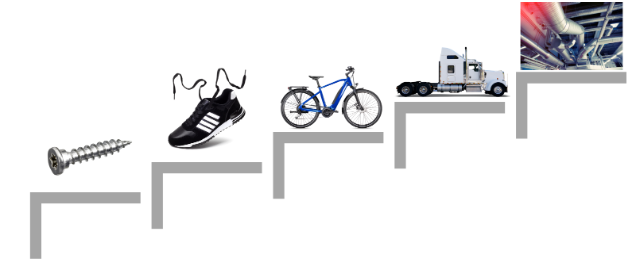Exploring the Limits of Configurator Compatibility with Complex Products
If you are selling B2B manufacturing products that are deeply individualized for each customer, you know the benefits of Configure-to-Order (CTO) compared to that of a manual and slow Engineer-to-Order (ETO) process. With CTO you increase sales speed, accuracy and win rates – especially with a configurator you can trust.
Can today’s configurators really handle the high level of complexity that B2B manufacturing products typically have?
Let’s look at what complexity could be and how configurators may address it.
- For standard and commoditized products with no variation you do not need configuration. An example could be a screw. These products can be sold through pick-to-order from a catalogue and have a repeatable and predictable order fulfillment process (production, delivery, installation).
- On the next level we find products that are individualized but have a small number of part variants. A shoe may have different kinds of strings that you may want the customer to choose from, but the number of string types is mostly limited. More importantly, there is no dependency between the string and rest of the shoe: You can basically select any string type without getting into conflict with the functionality of the shoe. These products may use simple forms of configurators (often with a visual component) but the selection of parts variants is almost on par with standard products selection.

- On the next level we find products that have tree-like assembly structure. A bike, for instance, consists of an assembly with subassemblies (e.g. frame, handlebar, front wheel, rear wheel, gears). For each subassembly there could be great variance (e.g. large selection of wheels and tires). Moreover, the selection of each subassembly or module is dependent on the selection of other subassemblies on the bike. For instance, some wheels and tires may be incompatible with the diameter and length of the frame fork. To avoid ordering faulty bikes, a configurator of bikes needs to keep track of these interdependencies. However, the number of subassemblies for a bike is static: at the time of setting up the bike configurator we know that a bike will only have one frame, one handlebar and two wheels (unless you are selling tandem bikes!). This makes the configuration problem less complex.
- On the next level of complexity, however, that is not the case. In these products, the number positions at which those assembles can sit, is not known at the time of creating the product model. A heavy truck, for instance, may have 4, 6, 8 or even 10 wheels, depending on load capacity. In these cases, the configurator needs to support dynamic positions, the number of which affects other parts of the technical solution (e.g., the chassis, drive line and gearboxes). Only a hand full of configurators can handle this level of complexity with acceptable performance and a reasonable level of maintenance.
- So even if a truck is complex, the range of positions are still finite and known. A heavy truck manufacturer may offer perhaps up to 10 wheels, but certainly not 40 or 100. But products with unknown scope do exist. Normally we call them systems. These products – for example HVAC systems, production lines, power distribution equipment, plants or wind turbine parks – typically have an organic and unbounded structure. The number of units in the system – and their spatial relations – is not known beforehand but may impact how the system performs. Each of those units may be complex and configurable in themselves, affecting the overall system landscape. Also, the ordering of the units may be important, especially in process flows systems. For a long time, these products have been deemed too complex for Configure-to-Order process and have been sold through manual Engineer-to-Order, causing long sales cycles, high cost of sales and costly quotes and order errors. Companies that have tried implementing a Configure-Price-Quote system for these products have suffered from performance issues and high maintenance costs of CPQ.
However, recent configurator technologies now enable manufacturers to confidently Configure, Price & Quote large-scale systems with low sales costs and great sales tool performance.
Interested in learning more? Join us for our webinar:
Configure anything with Tacton CPQ System Configuration
WEBINAR – AUGUST 17, 4:30 PM CET | 9:30 AM CDT

